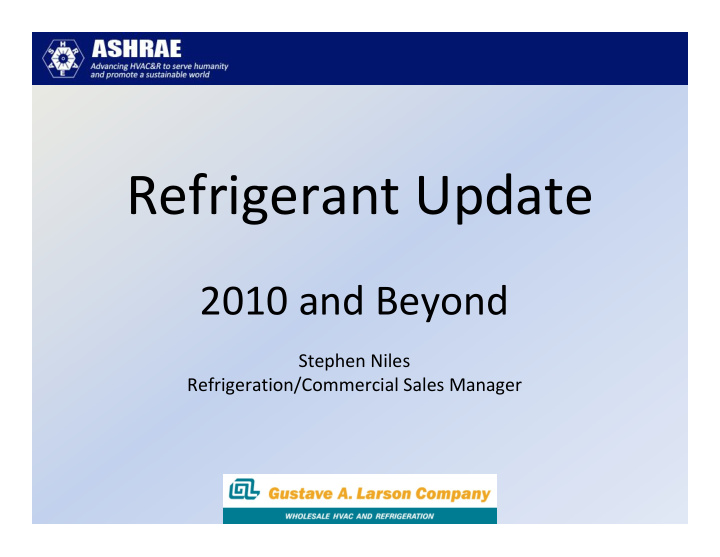



Refrigerant Update 2010 and Beyond Stephen Niles Refrigeration/Commercial Sales Manager
Agenda • Recap • Current Situation • Considering the Future
Governing Documents and Regulations • ANSI/ASHRAE 34-2001 • EPA SNAP Listing • Montreal Protocol • Section 605 of the Clean Air Act Jan. 21, 2003 • Montreal Protocol Meeting 19- September 2007 • EPA Rule Changes December 2008- Awaiting the Final Rule
Recap (P roblem/Solution Cycle) • Increasing need for refrigeration in expanding use in Food, Medical, Manufacturing(Process), and Comfort HVAC applications
Specification Criteria • Boiling Point between -50 and 0 C, to absorb heat at 0 and reject at 40 • Non-Flammable • Non-Toxic • Non-Corrosive • Economical • Capacity • Serviceability
Recap (P roblem/Solution Cycle) • Increasing need for refrigeration in expanding use in Food, Medical, Manufacturing(Process), and Comfort HVAC applications – CFC Solution
Recap • 1974 Rowland and Molina- Middle Stratosphere CFC’s breakdown by UV radiation releasing Chlorine atoms. Proposed that chlorine was breaking down Ozone. • Highly disputed. Congress funded research. • 1976 US National Academy of Sciences confirms the credibility of the ozone depletion hypothesis. • 1985 British Antarctica Survey- Ozone hole discovered over Antarctica • Vienna Convention – 1989 Montreal Protocol- substitutes must be found and ozone depleting substances must be phased out
Recap • United States Clean Air Act Amendments of 1990 contain provisions for implementing the Montreal Protocol and establishes explicit authority for the U.S. Environmental Protection Agency to regulate ozone depleting chemicals. • Industry slow to adopt and adapt to changes. • CFC production banned. HCFC set for phase out.
Current Situation • CFC’s- no production. Service use only through reclamation. • HCFC’s- Developed Countries (Article 2): Accelerated* Phase Out Schedule – 2004 35% reduction from baseline – 2010* 75% reduction from baseline – 2015 90% reduction from baseline – 2020* Stop production with 0.5% of baseline for service only until 2030 – 2030 No production or importing of HCFC’s *September 2007 Rules Change
Current Situation • Proposed rule changes under review – 2010 Allocation Rule • Reductions per existing Montreal Protocol • Production and import for servicing equipment produced prior to January 1, 2010 • Change to include consumption and production allowances for HCFC- 123, -124, -225ca, and -225cb currently not part of the allocation rule.
Current Situation – 2010 Pre-Charge Appliances Rule • Ban the sale or distribution of pre-charged systems and components manufactured on or after January 1, 2010. • Includes HCFC-22, HCFC-142b, and any blend containing these components. • Includes imported products. • Allowance made for servicing. • Some confusion with regard to field installed systems. • Special provision for systems charged with reclaimed refrigerant. • Publication of Final Rule still pending. See http://epa.gov/ozone/title6/phaseout/rulesoverview.html
Current Situation • HCFC phase out estimated to create 2010 imbalance between supply and demand (DUPONT estimates 27.5 million pound shortfall) • Alternatives- HFC’s – HVAC • R410A • R407C • R423A • R134a – Refrigeration • R404A • R507 • R134a
Current Situation • Concerns about availability and fit • Alternative Blends – Refer to SNAP Listing – Safety ratings – Base use for retrofit on fit, cost, availability, system operating characteristics, and complexity of the retrofit – No silver bullet – R438A, R407A, • HFC’s not the final answer- GWP
Considering the Future • Global Warming • European Influence • Government Intervention- EPA regulations, Carbon Taxes • Technological Developments • Special interests influence on Global Companies • Proliferation of Refrigerant Cocktails • Pushing the limits on safety- toxicity/flammability
Considering the Future • European call for phase out of R134a • Development of CO 2 systems and components • HFO1234yf (hydrofluoroolefin 2,3,3,3,-tetrafluoroprop-1-ene) • Equipment and system design – Self contained – Modular – Secondary Loop – Close coupled – Systems environments will change – Smart systems- self monitoring, automation – Safety monitoring – Radical Component changes
Questions
Recommend
More recommend